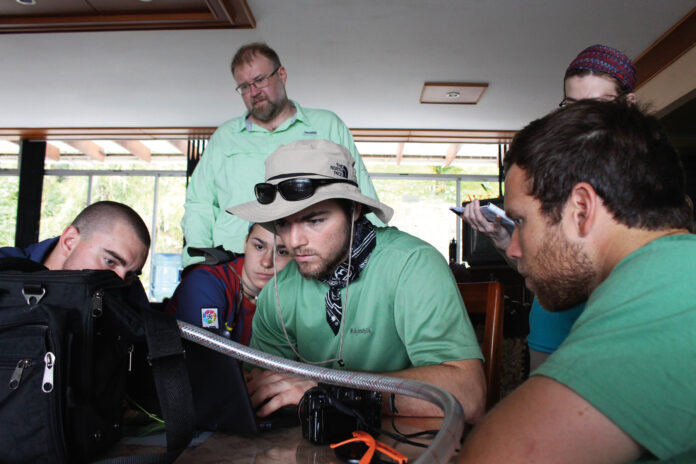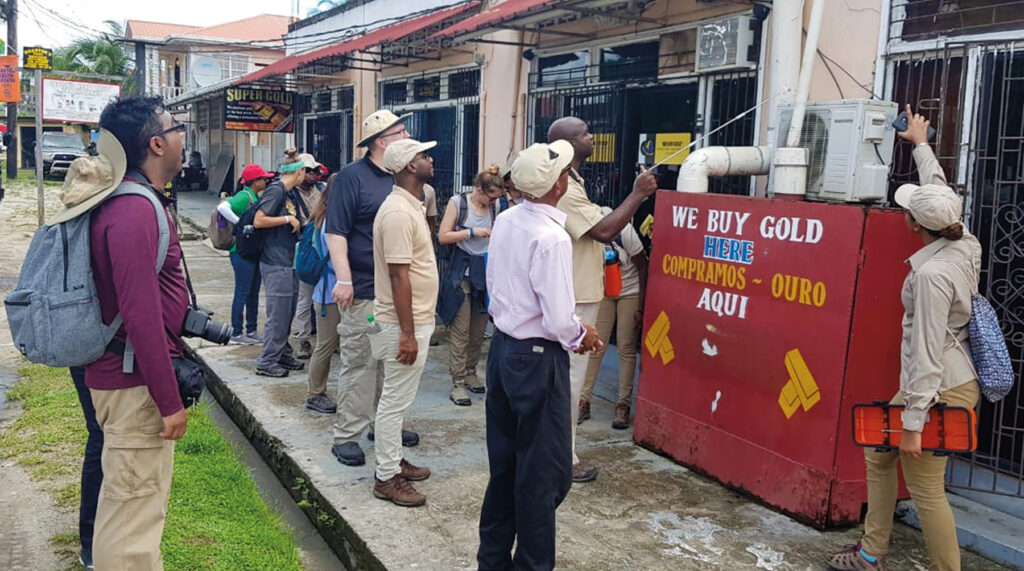
Millions of people in developing countries rely on artisanal and small-scale gold mining to feed their families. And while they produce 20% of the world’s gold, the use of mercury in the process comes at great cost to their health and the environment.

For over a decade, a team of Mercer University scientists and engineers has been working to make artisanal and small-scale gold mining safer and lessen the harmful environmental impacts, contributing to cleaner air and water across the globe.
“These miners are the number one source of mercury pollution on the planet, and they don’t do it because they don’t care about the environment,” said Dr. Adam Kiefer, Distinguished University Professor of Chemistry at Mercer. “They do it because they need to feed their families. They do it because there’s no formal training, mercury is cheap, it’s easy to use, and it’s portable.
“They are producing gold because that’s their livelihood. The problem is the collateral damage to the environment is huge.”
Dr. Kiefer’s laboratory at Mercer is one of few in the world dedicated to developing solutions to this global health crisis. He has led teams to four countries where artisanal small-scale gold mining is present to study the issue and work with in-country partners on solutions.
In collaboration with School of Engineering Dean Dr. Laura Lackey, Dr. Kiefer and students designed programs to monitor mercury contamination in artisanal and small-scale gold mining as well as systems for capturing mercury before it is released. In 2019, Dr. Kiefer and Dr. Lackey patented their Mercury Capture System, which has been shown to reduce mercury emissions by over 95%.
Now the team is researching ways to avoid mercury use in artisanal and small-scale gold mining altogether.
“Our goal here is, if possible, to avoid mercury use, but should mercury use become a component of mining to be able to introduce the Mercury Capture System on the front-end,” Dr. Kiefer said.
Building relationships
Dr. Kiefer’s research into artisanal and small-scale gold mining began in 2010 when he led a trip to Mozambique through Mercer On Mission, a study abroad and service-learning program dedicated to solving real-world problems.
Over the years, his work has shifted to Ecuador, Peru and Guyana. In 2024, Dr. Kiefer and Dr. Addie Buerck, assistant professor of environmental engineering, will lead a team to Belize.
“Belize now has small amounts of artisanal and small-scale gold mining, and we are hoping to prevent the problem of mercury in the environment before it starts,” Dr. Kiefer said. “We have aligned with the University of Belize and are working toward making formal relationships with the government so that we can bring our wealth of expertise in artisanal and small-scale gold mining to a country before they have a problem.”
The team’s work with in-country partners is critical to its success. That means talking to miners, gold shop owners, governmental agencies and other interested parties, and working on solutions together.
“Our goal here is, if possible, to avoid mercury use, but should mercury use become a component of mining to be able to introduce the Mercury Capture System on the front-end.”
Dr. Adam Kiefer, Distinguished University Professor of Chemistry
Miners use mercury in the field to extract gold from ore, heating the resulting mixture to remove the majority of mercury and produce impure gold that can be sold. Then, gold shop owners melt the impure gold, releasing the remaining mercury into the air.
These mercury vapors are highly toxic, and the conventional practice of using an open flame to heat the mercury spreads the dangerous vapors throughout the environment.
Breathing in mercury vapors can damage the body’s nervous system, lungs and kidneys. Vapors can easily pass into the bloodstream, also affecting the brain. Miners and gold shop owners have died from mercury poisoning, Dr. Kiefer said.
In addition, the mercury emitted into the air infiltrates the environment, settling in waters where it pollutes fish and enters the food chain, putting the world at risk.
Despite the danger, adopting new technology can be expensive and feel risky to miners and gold shop owners, many of whom use tried-and-true techniques passed down through generations. By working with the miners and gold shop owners, the Mercer team can address their concerns while also introducing solutions.
“People are accepting of us when they find that we come back and we work with them, not for them or against them,” Dr. Kiefer said. “It takes years to develop the relationships that we have, and we don’t take that lightly.”
On the ground
When Dr. Kiefer and his team arrive in a country, they first identify where mercury pollution is the most concentrated. Using special instrumentation and GPS, they walk the area, mapping mercury levels. The highest concentrations typically are around gold shops, he said.
From there, they work with gold shop owners to retrofit existing ventilation systems or construct new ones with the Mercury Capture System. They also install induction heaters, which provide a safer way to heat gold than using an open flame. With the changes in place, the team remeasures mercury levels to demonstrate the decrease.

Students are critical to the Mercer team’s work. With faculty guidance, they collect data to map mercury pollution in the towns, identify hot spots and find materials to design, build and test the Mercury Capture System on site, Dr. Lackey said. While the team brings key components with them, the system is constructed from accessible materials on site.
“From the students’ perspective, I think that it’s important to get outside of the bubble that you’re used to — being able to experience a new culture, new traditions and everything. That is impactful for students who might not have traveled before or seen other people’s ways of living,” said Samantha Brown, who graduated from Mercer in 2021 with a neuroscience and chemistry double-major.
Brown participated in two Mercer On Mission trips to Peru and Guyana with Dr. Kiefer and continued her work with him after graduation as an adjunct faculty member. She is currently pursuing her Ph.D. in chemistry at the University of Illinois and in 2023 was selected for the National Science Foundation’s Graduate Research Fellowship Program.
In college, “a lot of research is inside of a laboratory with a known protocol,” Brown said. “Being able to be creative, outsourcing things and developing the Mercury Capture System on the spot and then employing it into a useful system is a really rewarding experience.”









